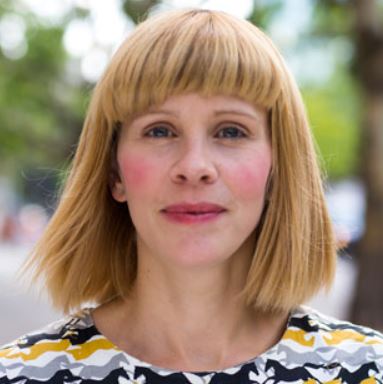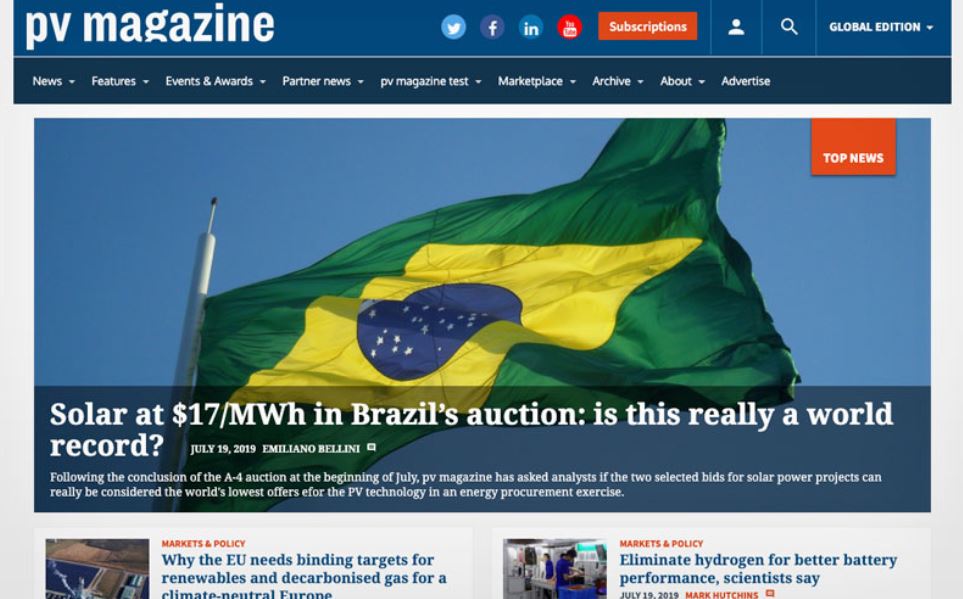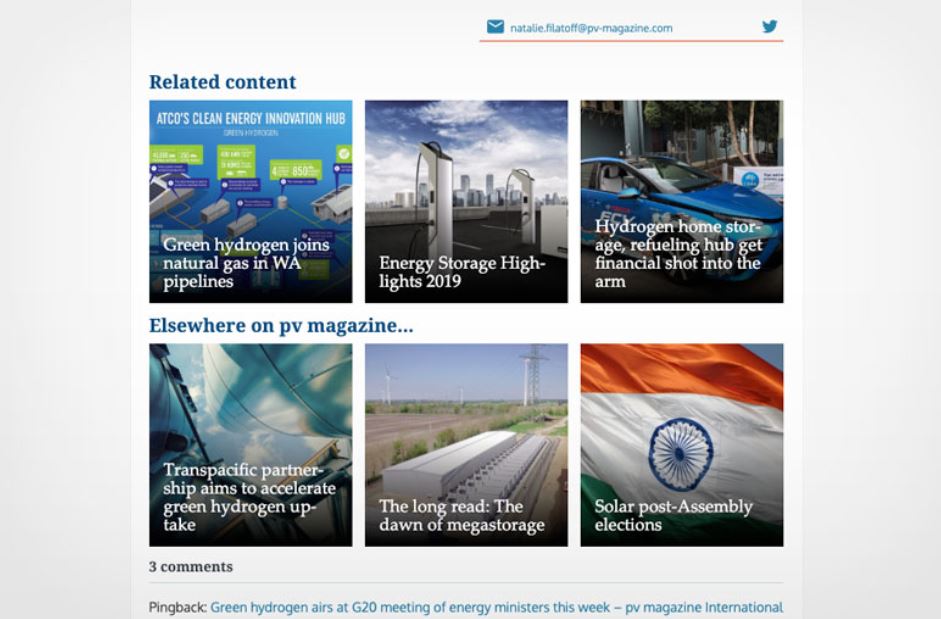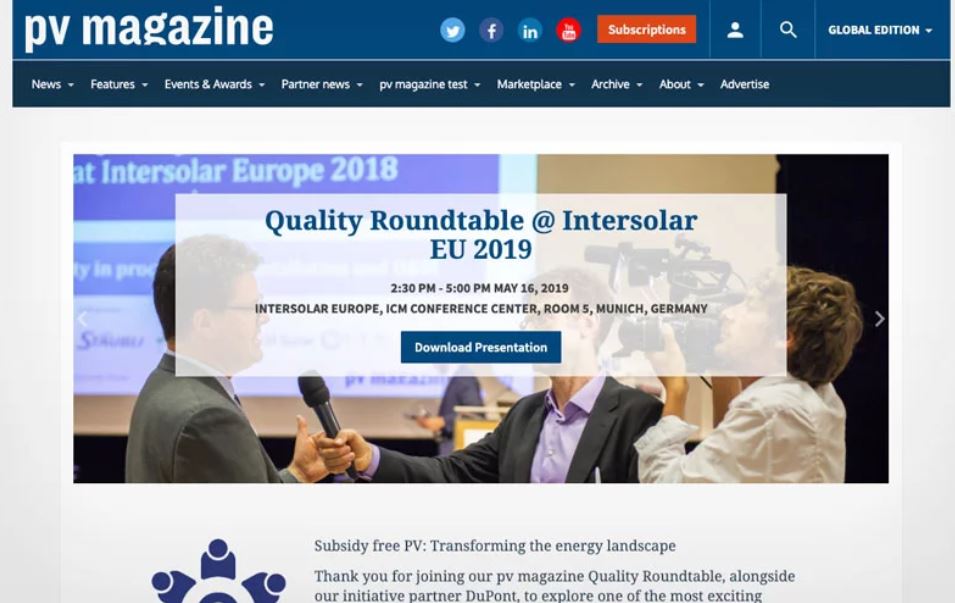Audience engagement experts Bibblio are shining a spotlight on the many multi-platform magazine publishers that are thriving via its “Vertical Heroes” series of interviews. Here, Bibblio Co-Founder Mads Holmen speaks with Berlin-head quartered pv magazine, which also has an Australian base, about going beyond the press release in their news reporting, branching into events, and being willing to change strategy if something doesn’t work.
In this ninth edition of “Vertical Heroes”, we hear about the success story of pv magazine, a publication offering daily updates on photovoltaics in many local markets worldwide.
Alongside this network of sites there is also a print publication that launched in 2008. The Berlin-based magazine considers itself an independent technology-focused community that’s the best place to discover news, trends and global market developments in solar photovoltaics.

Bibblio CEO Mads Holmen had a chat with pv magazine’s Senior Manager Marketing and Events Marina Ramain, and Head of Content Becky Beetz about going beyond the press release in their news reporting, branching into events, and being willing to change strategy if something doesn’t work.
Mads: Who is pv magazine’s target audience?
Marina Ramain: We target global solar photovoltaic and energy storage professionals, from across the value chain.
M: What different types of content are you offering these professionals?
MR: Currently we have 10 websites, including our flagship global edition, and daily newsletters in six different languages. The latest addition is our regional French news platform. We also publish print editions including a monthly global magazine, a quarterly German magazine, and various other annual editions. Finally, we produce webinars, events such as roundtables, and podcasts.

M: How large is pv magazine in terms of audience and staff?
MR: We have a print circulation of around 35,000 readers globally. As for the staff, we have a small team, which always surprises people. In Berlin, we are around 15 employees from various countries: Germany, UK, Japan, China, the U.S., Australia, France and Italy. We also have an office in the U.S. and of course many editors reporting from around the globe.

Becky Beetz: We attract over half a million monthly users online, and the numbers continue to grow with each passing year.
M: You’ve managed to grow impressively, adding new sites along the way. What has been the secret sauce?
MR: Our secret sauce consists of high-quality editorial content, a comprehensive cross platform strategy for all of our global and regional platforms, and a strong social media strategy, all of which are regularly evaluated and adapted. We also attend the largest international solar trade shows.
BB: By continually evaluating our content against our readers’ needs and the newest industry trends, we ensure it is focused on the key issues. We’re always on the lookout for how to add more value via regular strategy meetings. And of course, key to our work is high quality, factual reporting that goes beyond the usual press release, creating real value for our readers. Through this, we have earned a strong reputation.
M: Can you share some stats on the business to illustrate the growth of pv magazine?
BB: All of our digital platforms have grown year-on-year, in terms of users and sessions. For example, the global website launched in 2010. Since then, we have grown to attract over 200,000 users monthly to this site and this figure keeps increasing. The same goes for our webinar business, for example. Each year, the number of webinars and associated revenues has grown impressively.

M: What are the key audience metrics pv magazine defines success by?
MR: We measure both sessions and users in our analytics program, and also look at the time spent on the various sites, which helps to evaluate the quality and attractiveness of our content. Another area we focus on is the number, and profile, of attendees at our events. This is usually where we can evaluate how much our content has helped create our strong reputation.
BB: We also track the most popular articles, in order to tailor content to our readers’ interests; and keep an eye on the comments section, which can provide insight into areas of debate and new issues.
M: So you would describe pv magazine as data-driven?
BB: Very much so. Next to continually evaluating data from our analytics program, we also take all feedback we receive seriously, both internally and externally. This is true for our events strategy too, as Marina mentioned.
Only by understanding what motivates our readers and clients can we offer a product that successfully meets their needs and thus grows our business. That’s why we branched out into events – we followed the demand. Going forward, we aim to use analytics on a deeper level by offering tailored content to individual readers.
M: What’s pv magazine’s social media strategy?
MR: We feed all news articles from the digital platforms onto our various social media and share content from our print publications. We create extra content to engage our audience further, like re-posting the most read articles each week, sharing the latest magazine cover each month, and publishing interesting graphs from the print magazine, etc.
Another key point is to encourage our editors to post on their own social media channels. Our audience is a B2B audience and we clearly see the biggest potential for us on LinkedIn. We use a little bit of paid advertising when we identify an article with a big engagement potential.
M: How do you prioritise attracting new audiences vs. engaging existing users deeper?
BB: Both are crucial to our business. By continually reviewing and adapting our editorial and marketing strategies, in addition to keeping abreast of the latest trends and working closely together with industry, we not only continue to grow our reader base year on year, but we also successfully forge lasting relationships.
M: How do you drive engagement when readers land on your site?
BB: We use Bibblio’s widget on all of our 10 websites, to improve our ‘Related content’ section. A second Bibblio widget, called ‘Elsewhere on pv magazine …’, has been installed to promote cross-pollination between the different sites. Furthermore, where appropriate, we highlight our various webinars and roundtables in news articles via the use of call out boxes, and always link to related news items within stories.

To promote the magazine, we publish a ‘Weekend read online’, featuring articles from the latest edition, free of charge. We further encourage readers to connect with us via the comments section. When they do, we ensure we respond.
M: Could you shed a bit of light on the ways you drive revenue?
BB: Content marketing is a big driver for us. We offer a number of opportunities, including ‘Powered by’ news articles, special print editions, white papers, podcasts and feature pages. Each package is individually tailored to a client’s needs.
We also sell webinar and roundtable sponsorships, and of course, traditional advertisements. Overall, we very clearly mark that the content has been paid for. This is important to us in terms of maintaining a high level of editorial integrity, and for readers it maintains a level of transparency that also ultimately benefits the paying client. We definitely see the trend for more content marketing, which offers readers real value, and the keenness of companies to adhere to our editorial style to communicate their messages.

M: How do you drive site visitors to the sponsored content?
BB: We have established a ‘Partner news’ section in our menu bar, which features all paid for content. Additionally, we push new special editions, for example, on our ‘Announcements’ box on the home page, in our various daily newsletters, and on social media. If we are working with a webinar or roundtable partner, we will publish Q&A articles with them prior to and following the event, and send out separate mail shots encouraging participation. As we are a B2B media platform, the content is usually engaging and relevant to readers, so it attracts a high level of participation.
M: What’s the area you’re most excited about?
BB: The digital space is particularly dynamic in that it offers a number of potential areas for improvement in terms of design, content, and deepened reader engagement. How news is delivered and read is changing fast and learning about these developments is fascinating. Events is another growth area with massive potential.
M: Why do you think your model has been successful?
BB: In addition to caring deeply about the quality of content we deliver, and regularly adapting our editorial strategy to fit the needs of the industry, we have also been flexible in recognising new business opportunities.
M: From pv magazine’s journey, what do you think other vertical publishers could learn?
BB: By really caring about what you are doing, you are much more likely to produce high-quality, meaningful work. It is also vital to stay flexible, follow (or set) trends, and recognise that if one strategy does not work, another should be employed. Key to a successful work environment is also recognising the contribution of all team members. If they feel valued, they will care about what they are doing, and then, like I said, the quality of work produced is likely to be that much better.
M: Lastly, which other publishers do you look to for inspiration?
MR: The Business of Fashion, obviously, which is really a reference for any B2B publisher. Then, I like to check out what Welcome to the Jungle does. They’re a French company that aims at being the biggest media talking about professional lives and they do it really well: amazing design, great events, a massive amount of engaging content in various formats. Their team is very agile and grew incredibly fast in the past few years.
BB: There is a great book out, published last year, called Newspaper design, which features case studies from the world’s most iconic newsrooms. They include the Guardian, the New Yorker, El Mondo, etc. It is fascinating to see how such names have changed over the years, particularly with the development of digital. Seeing what they are doing sets a strong benchmark for other media companies.
To view the original interview, visit Bibblio’s website.





